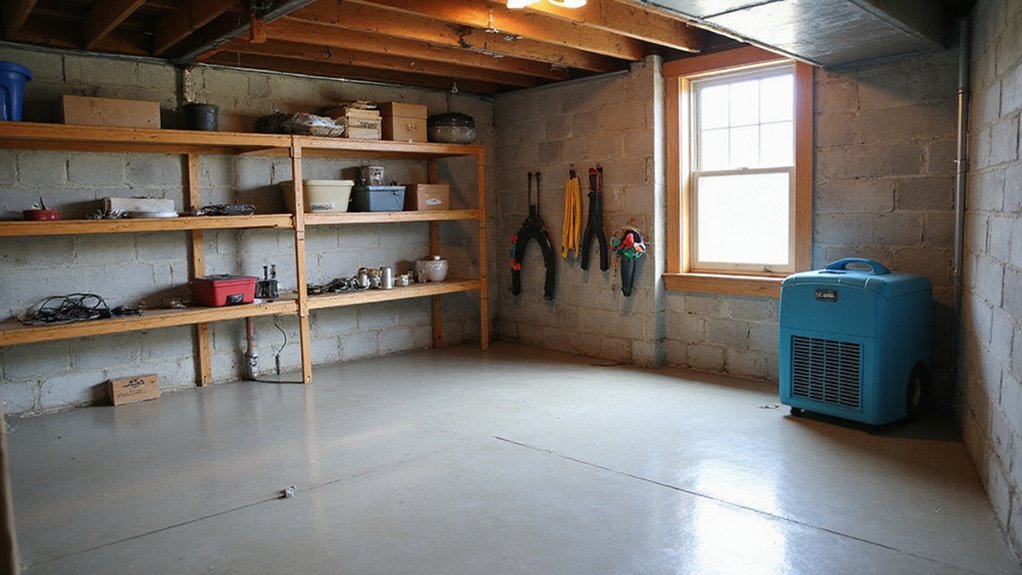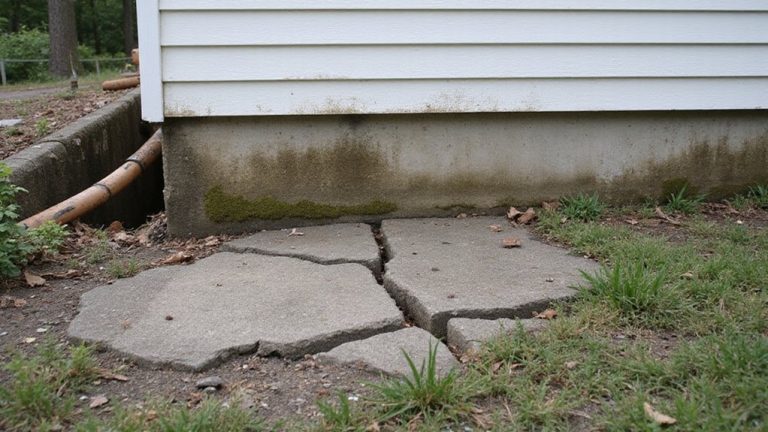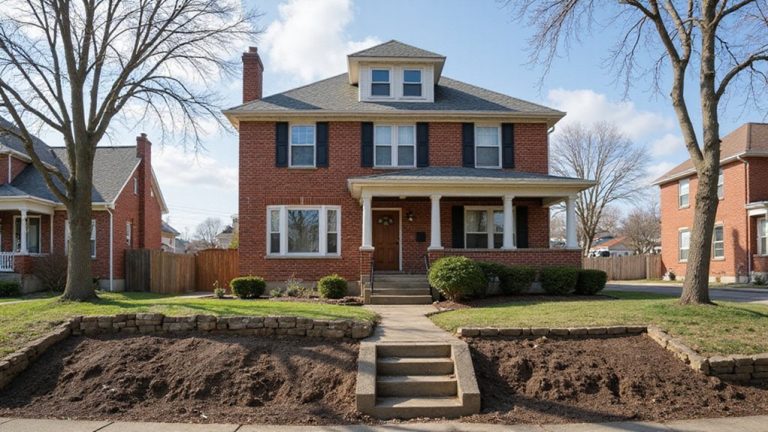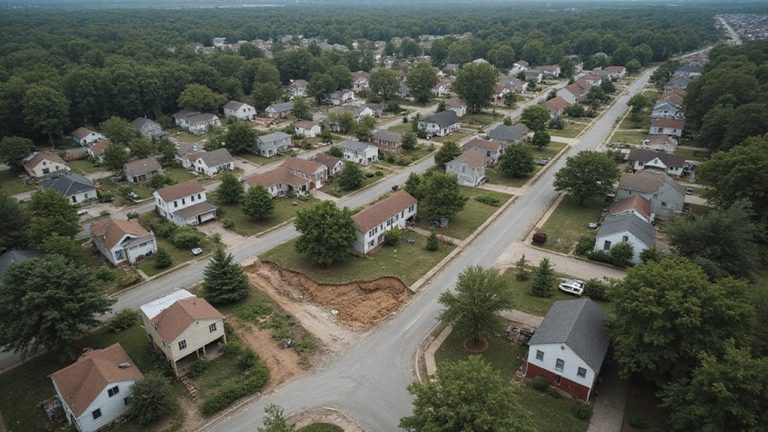After your basement’s foundation has been repaired, preserving it is vital to guarantee long-term stability and prevent future issues. Regular inspections can identify structural concerns and signs of pests or mold, allowing for prompt remediation. Proper drainage systems and waterproofing measures enhance energy efficiency and create a dry, comfortable basement environment. Monitoring for cracks or leaks and maintaining adequate ventilation are also indispensable steps to safeguard your investment and create a livable space. Uncover the key steps to effectively maintain your basement and protect your home.
Inspecting the Basement
After your foundation has been repaired, it’s important to carefully inspect your basement to confirm everything is functioning properly.
First, identify any structural concerns, such as cracks, settling, or water damage. Evaluate the insulation needs to ascertain your basement maintains a comfortable temperature and prevents moisture buildup.
Check for signs of pests or mold, and address any issues promptly. Regular inspections will help you stay ahead of potential problems and keep your basement in top shape. Remember, a well-maintained basement can add meaningful living or storage space to your home. Foundation repair experts recommend scheduling periodic professional inspections to catch any potential issues early and prevent costly damage.
Addressing Drainage Issues
Proper basement drainage is essential to maintaining a dry and healthy living space. Addressing drainage issues around your home can help prevent water intrusion and costly foundation repairs down the line.
Improving soil grading by ensuring the ground slopes away from your home’s foundation. This helps direct water runoff away from the basement.
Ensuring proper downspouts and extending them at least 6 feet from the home. This prevents water from accumulating around the foundation.
Considering installing a French drain system to capture and divert excess groundwater. Water damage prevention is critical for homeowners in areas like Cleveland, Ohio, where moisture can cause significant structural issues.
Waterproofing the Basement
Once you’ve addressed any drainage issues, you’ll want to deliberate waterproofing your basement. Waterproofing is critical to keep your newly repaired foundation safe from moisture.
Consider installing a dehumidifier to manage humidity levels and a vapor barrier to prevent moisture intrusion. These steps will help protect your investment and guarantee your basement remains dry and comfortable.
Proper waterproofing can also amplify your home’s energy efficiency, making it a prudent long-term solution. With a little effort, you can create a dry, healthy basement environment that you’ll enjoy for years to come.
Monitoring for Cracks or Leaks
Regularly monitoring your basement for cracks or leaks is an essential step in maintaining the integrity of your newly repaired foundation. By staying watchful, you can quickly identify and address any issues before they escalate.
Check for dampness on the walls or floor, which could indicate water seepage. Observe any water seepage or dripping, noting the location and severity. Inspect the basement regularly, particularly after heavy rain or snowmelt, to catch problems early.
Addressing cracks or leaks promptly can help prevent further damage and guarantee the long-term success of your foundation repair.
Maintaining Basement Ventilation
Safeguarding proper ventilation in your basement is indispensable, as it assists in regulating moisture levels and prevent mold growth. Preserving adequate airflow and humidity control is pivotal for your basement’s long-term well-being.
By carefully managing the temperature and air circulation, you can create a comfortable and healthy environment. Consider installing a dehumidifier to control moisture and pair it with strategic ventilation to guarantee proper airflow.
Proper ventilation not only improves your basement’s livability but also shields the integrity of your home’s foundation. Prioritize this maintenance to enjoy a dry, comfortable, and mold-free basement.
Addressing Moisture and Humidity
Since addressing moisture and humidity is essential for maintaining a healthy basement, it’s important to regularly monitor and manage these factors.
Reduce condensation by ensuring proper insulation, sealing air leaks, and using a dehumidifier. This will help prevent mold and mildew growth.
Optimize dehumidifier performance by cleaning the filter regularly, emptying the collection tank, and positioning the unit strategically to maximize coverage.
Monitor humidity levels and adjust the dehumidifier settings accordingly to maintain an ideal humidity range, typically between 30-50%.
Protecting Basement Floors and Walls
Safeguarding your basement floors and walls is indispensable after addressing moisture and humidity concerns. Leveling uneven basement floors is important for safety and aesthetics.
Sealing cracks and crevices in the walls with a high-quality sealant can prevent further water damage. This protects your investment and enhances the overall look of your basement. Don’t overlook these pivotal steps in maintaining your newly repaired foundation.
Taking the time to properly care for your basement floors and walls will guarantee your home remains dry, comfortable, and structurally sound for years to come.
Scheduling Regular Maintenance
How often should you schedule regular maintenance for your newly repaired basement? Experts recommend scheduling maintenance at least once a year to safeguard your basement remains in top condition.
Staying on top of regular maintenance is key to protecting your investment and preventing future, costly foundation problems. By creating a schedule and adhering to it, you’ll give your basement the care it needs to last.
- Inspecting the foundation for any new cracks or signs of movement
- Checking the basement walls, floor, and windows for water leaks or damage
- Reviewing your maintenance records to identify any recurring issues
Frequently Asked Questions
Can I Convert My Basement Into a Living Space?
Converting your basement into a living space is possible. Investigate basement layout options to maximize your space. Consider additional basement amenities like a kitchenette or entertainment area to create a cozy and welcoming living environment.
How Do I Prevent Mold Growth in My Basement?
Use a dehumidifier to manage moisture and prevent mold in your basement. Regular maintenance and monitoring will keep the space comfortable and healthy for you and your loved ones.
What Type of Flooring Is Best for My Basement?
Consider waterproof flooring options like vinyl or laminate to protect against moisture. Concrete floor sealants can also help create a durable, moisture-resistant surface for your basement space.
How Do I Insulate My Basement Properly?
For your basement, consider blown-in insulation or rigid foam panels. Seal any cracks and gaps to prevent air leaks. Insulating properly can enhance comfort and energy efficiency – just follow DIY basement insulation tips to get it done right.
Can I Add Windows to My Basement?
You can add windows to your basement to improve ventilation and augment the aesthetic. Investigate various basement window styles that suit your needs and complement your home’s design, creating a welcoming and well-lit space.



